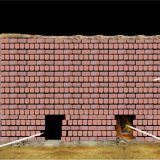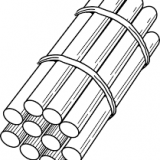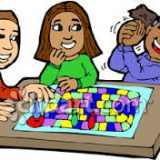Olo Igbi: The Spinning Snail Shell Game
![]()
One of the first games many Idoma children can remember playing is “Olo Igbi”, an indigenous spinning game played using crafted snail shell. The African land snail (Lissachatina fulica) is a common sight in gardens, around damp corners of fences, under grasses, on refuse dumps, and by the river side. Although most homes in Idoma Land in Benue State, North Central Nigeria, do not eat snails, children are not afraid to capture live snails, recluse in their shells, and left in the sun to force them out. Once the warmth of the sun forces the snail to move, it is easy to pin the snail to the ground with a stick and pull off the hard shell.
 Once the helpless occupant of the shell has been dislodged, the children get to work crafting a conical half shell out of the empty snail shell. To smoothen the now circular opening, the top is gently rubbed against any smooth concrete surface.
Once the helpless occupant of the shell has been dislodged, the children get to work crafting a conical half shell out of the empty snail shell. To smoothen the now circular opening, the top is gently rubbed against any smooth concrete surface.
The Olo Igbi Game
The crafted conical shell itself is called the “Olo Igbi”, with the term igbi being the Idoma word for snail and olo roughly standing for the conical shell. Thus, the call to play the spinning snail shell game is “a’lo to’ Olo Igbi” (a’lo means “let us” while to’ means “play”). The conical shell is held tightly upright by the thumb and any of the other fingers, and spinned by a proportionate force, moderate enough to maintain the stable spin (“dance”) of the cone on its vertex. The usual surface for playing the game is the ground, covered with fine sand to sustain the “dance” of the spinning cone.
Spinning the Olo Igbi onto fine sand is the typical format of the game, the starting point for learners. As one graduates from being an amateur to a professional player, the standard is to spin the conical shell onto the other palm or even spinning it up onto the same palm. Different styles can be introduced at this stage, including the the popular “King Kong” style involving swapping between both the palm and the back of the hand while the shell is still spinning.
The Olo Igbi game can be played by two or more players, taking turns clockwise or anticlockwise while seated on the ground. There are usually no umpires as the rules and styles are determined by consensus.
Scoring and Rules
The Olo Igbi game is not all about spinning the conical shell well. The player scores by manipulating the spinning cone to cover the sand, a feat called “o’kla” in Idoma. This means the point for a round is earned after successfully making the spinning cone to cover the ground with its circular base.
For instance, if three players have agreed to play on fine sand and have determined that the turn of play is clockwise, the first player begins and attempt to cover. A successful covering gives him a win point, in which case he awaits the outcome of the round. If the attempt is unsuccessful, he remains in the game. Basically, the loser is the player who could not cover the cone after everyone else has done so. Depending on the seriousness of the game, the loser is punished in a predetermined scheme called “I’kpa” or the loser is just booed. A serious “I’kpa” scheme may involve all successful players taking their turn to strike the back of the hand of the loser with the vertex of the cone. This extremely forceful spin can actually hurt the back of the hand, and as such the “I’kpa” scheme of punishment is only collectively adopted by professional players. Even in such cases, a “friend” may decide to “ba”, pardoning the loser.
At its most difficult level, the covering area may be restricted to marked out area on the sand. An extreme level even involves marking out specific circles with the circular base of the cone and attempting to cover the Olo Igbi on the marked-out circles, with players agreeing to reduce the numbers of circle after each successful covering or iteration. These circular markings may be the children’s first exposure to the five-circle symbol of the Olympic.
The skill required for the game is the ability to make and sustain a strong spin of the conical shell. The difficulty with creating a steady spin has led to other variants of the game. These easier variants were also necessitated by the extreme level of craftiness required to make the conical shell without shattering the entire brittle snail shell. A common variant of the Olo Igbi is the popular “koso” game made by fixing plastic pen covers into plastic lids of torch batteries. This form of the game brings efficiency to each spin, enabling players to introduce diverse styles.
Mathematical Significance of Olo Igbi Game
The craftsmanship required to make the conical-shape game out of the very brittle snail shell is an art to be desired. Attempting this craft making with pupils may be a worthwhile reconnection to their environment, instilling a sense of carefulness and handwork.
The entire play of the game can be used to explain key mathematical concepts at the Basic Education Level. Apart from the aesthetic value of this inexpensive game, concepts of shape, force, counting, and recording can be buttressed by the Olo Igbi game. The tool of the game itself is a rough approximation of a cone, a solid shape with a pointed vertex, a slant side, a vertical height, a curved surface area, a circular base, and a conical volume. Pupils can be lead to craft the Olo Igbi as mathematical models of the cone. By creating time to play the game, pupils can be taught how to record the duration of a spin, measuring the time taken to complete a given style, and relating such duration to the magnitude of the force producing the spin. Proportion and Variation can be explained from the relationship of force to duration as observed in the game.
The mathematics teacher can creatively build his or her own learning points on any aspect of the game. Innovatively blending the game into related lessons can stimulate learners’ interest in the concepts being discussed.
Views: 1158















